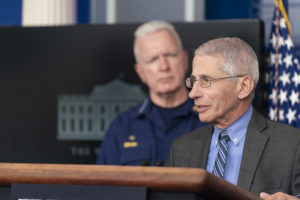
Dr. Anthony S. Fauci, Director of the National Institute of Allergy and Infectious Diseases, and a member of the White House Coronavirus Task Force delivers remarks at a coronavirus (COVID-19) update briefing Monday, April 6, 2020, in the James S. Brady Press Briefing Room of the White House. (Official White House Photo by Shealah Craighead)
On his blog, Dr. Joseph Mercola explains how Dr. Anthony Fauci took control of America’s growing biosecurity complex. He writes (abridged):
The Rise of the American Biosecurity State
To understand how and why the CDC has morphed into an agency that works against, instead of for, the public good, we need to take a look at the history of American biodefense. Two journalists have recently dedicated articles to this issue.
In an August 29, 2022, Unherd article,6 Ashley Rindsberg reviewed how Dr. Anthony Fauci rose to power as the highest paid federal employee, sitting at the “very top of America’s biodefense infrastructure,” with near-unlimited authority, at least as it pertains to science; what gets funded and what doesn’t.
“To understand the rise of Fauci … we must return to the first months of the 2000s, when a hawkish new administration was settling into power,” Rindsberg writes. George W. Bush came into office with Dick Cheney as vice president. Cheney had already served as defense secretary under George H.W. Bush.
According to Rindsberg, the Bush administration “came to power with biological weapons and infectious disease very much top of mind, with Cheney seeking to address the gaping hole in America’s national security left by the country’s lack of a coherent biodefense strategy.”
Biodefense became an even more prominent concern in the aftermath of 9/11, when letters containing anthrax were sent out to members of media and two U.S. senators. Of the 22 people infected with anthrax, five died. According to Rindsberg, Cheney “served as the political engine behind a paradigm shift that would soon take place in America’s biodefense strategy.”
Biodefense for the 21st Century
Just six days before 9/11, Joe Biden, then-chair of the Senate Foreign Relations Committee, had led a hearing on the threat of bioterrorism and the spread of infectious diseases.
Subsequent to that hearing, in June 2002, president Bush signed the “Biodefense for the 21st Century”7 directive, the aim of which was to advance a “comprehensive framework” for U.S. biodefense, based on the assumption that America could be devastated by a bioweapons attack.
The directive outlined “essential pillars” of the U.S. biodefense program, including threat awareness and vulnerability assessment, prevention and protection, surveillance and detection, response and recovery. The year before, in June 2001, senior policymakers had also performed a two-day tabletop simulation of a smallpox attack called Dark Winter.
“Intended … to expose vulnerabilities, the operation showed how quickly a public health disaster could lead to widespread chaos and social collapse. This was the stuff nightmares are made of — and, by all accounts, those were the nightmares that Dick Cheney was having,” Rindsberg writes. He continues:8
“Significant as it was, [Cheney’s] transformation of America’s biodefence framework was part of a much larger repositioning of long-term geopolitical strategy, an effort also led by Cheney.
In the aftermath of the Soviet Union’s collapse in the early Nineties, Cheney, then Secretary of Defense under George H.W. Bush, along with Undersecretary of Defense Paul Wolfowitz, began formulating a grand strategy for the post-Cold War era.
This plan, revealed in an infamous leaked memo,9 was rooted in a single strategic objective: America should permanently remain the world’s superpower. Its architects argued the US would do so only by preserving ‘strategic depth’ to ‘shape the security environment.’
The initial leaked memo was later reworked by Cheney’s chief of staff, Scooter Libby, who broadened the concept10 of ‘strategic depth’ to cover not only geographic reach but also an ability to wage war with weapons that could not only cripple an enemy’s military capabilities but disrupt its political, economic and social stability.”
How Biodefense Became Fauci’s Domain
In 2002, the Bush administration quintupled biodefense spending to $317 million. That same year, Severe Acute Respiratory Syndrome (SARS), broke out in China, and in 2003, just as SARS was being contained, H5N1 avian influenza emerged.
The back-to-back outbreaks acted as fuel for the erection of a biosecurity state, and in 2003, the Bush administration increased the annual biodefense budget to $2 billion — a staggering sum at the time. Bush also earmarked another $6 billion for the development and stockpiling of vaccines over the next decade.
But funding was only part of the challenge. To truly prepare for a bioweapons attack, research had to be conducted and coordinated, and to that end, Cheney brought all biodefense research programs under the purview of a single entity — the National Institute of Allergy and Infectious Diseases (NIAID), led by Fauci.
So, since 2003, Fauci has been responsible for “civilian biodefense research with a focus on research and early development of medical countermeasures against terrorist threats from infectious diseases and radiation exposures.”11
What’s more, as explained by Rindsberg, “as far as NIAID was concerned, there was no meaningful administrative distinction between biodefense and scientific research. With the stroke of Cheney’s pen, all United States biodefense efforts, classified or unclassified, were placed under the aegis of Anthony Fauci.”
This, in a nutshell, explains Fauci’s power. As the head of the biodefense infrastructure, Fauci has, for decades, had an open channel straight into the top office of the White House. He’s also exempt from oversight. For all these years, he’s had carte blanche to approve and run whatever biodefense research he wanted, without anyone telling him otherwise.
It also explains why he’s the highest paid employee in the federal government, making more than the president himself. A significant portion of Fauci’s $417,600 annual salary12 is compensation for his biodefense research leadership.
COVID-19 Is Fauci’s Grandest Failure
As top dog of biodefense research, it was Fauci’s job to prevent COVID-19 from devastating the U.S. Instead, in 2017, he confidently announced that then-president Trump would “no doubt” have to face a “surprise infectious disease outbreak,”13 and then went on to issue a never-ending series of conflicting recommendations as head of the White House Coronavirus Response team.
Fauci also led efforts to suppress discussion about the origin of COVID-19, as detailed in “Liars, Propagandists and The Great Reset.”
In January 2022, House Oversight Committee Republicans released National Institutes of Health emails showing Fauci and now-former NIH director Francis Collins spearheaded the effort to bury the lab leak theory, even though the consensus in early February 2020 was that the virus likely leaked from the Wuhan lab — and that it appeared to have been genetically engineered.
February 4, 2020, Fauci and Collins received a draft of the article, “The Proximal Origin of SARS-CoV-2,” later published in Nature Medicine.14 The original draft has never been released to the public, but we do have an email reply from Fauci, in which he objected to the inclusion of serial passaging through humanized mice.
In its final form, the Nature Medicine article roundly dismissed the idea that the virus originated in a lab, proposing instead that it must have evolved naturally, even though no actual evidence for that existed.
If you’re willing to fight for Main Street America, click here to sign up for the Richardcyoung.com free weekly email.




